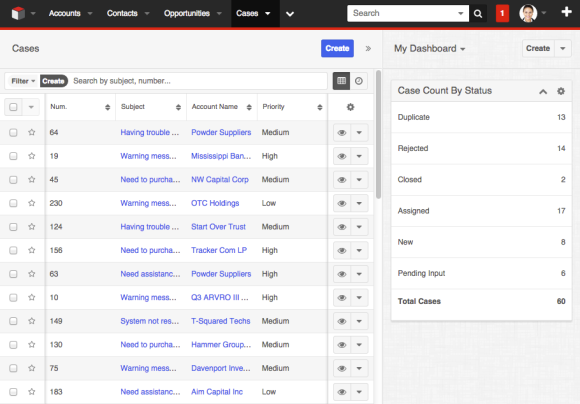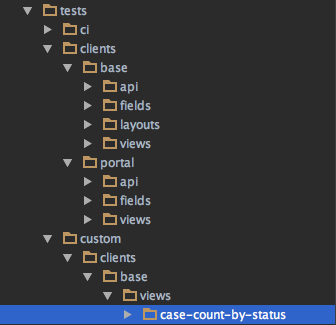This tutorial will cover the creation of new Jasmine unit tests for testing your Sugar 7 front end code.
In order to follow this tutorial, you will need access to the Sugar 7 Unit Test repository. Make sure you have the latest code. If you do not have access, then request access here. You must be a current SugarCRM Customer or Partner.
The key concepts for testing your Sugar 7 JavaScript code will be the same no matter the framework in use.
Testing a Dashlet
In order for this to be a realistic example, we need to identify a Sidecar component that we want to test. You could write your test against any part of the Sugar application including the out of the box Sugar 7 Sidecar components but lets take a moderately complex dashlet that we introduced in a previous blog post called Creating a Dashlet for Sugar 7 List Views.
The Case Counts by Status dashlet that was designed to be installed on Sugar 7 Contacts, Accounts, or Cases List Views. It queries Sugar and shows a quick summary of the number of Cases in each status.
For convenience, here is a direct link to the Case Counts by Status controller code.
We will be writing Jasmine tests for this custom dashlet. So follow the steps in Creating a Dashlet for Sugar 7 List Views to install the custom dashlet into your Sugar custom folder in order to follow along. If you already have a dashlet or view you want to test instead then you will need to tweak the examples below to match.
Creating our first Jasmine test
For detailed documentation on writing Jasmine tests, please refer to the Jasmine documentation. In this section, we are going to assume you are familiar with some of the Jasmine basics, such as working with specs, expectations, and file structure.
If you follow the steps to deploy the Sugar 7 unit tests (for example, here are the steps for installing unit tests in Sugar 7.6), you will have a test/ directory that is added to your Sugar 7 installation that includes many test files. You will have Grunt and Karma installed too.
By convention, the tests/ directory mirrors the file structure of the rest of the Sugar application.
This means that when creating tests for our Case Count by Status dashlet, we will be creating them within a new file under the tests/custom/ directory.
To try our basic Sidecar test example, create the file below at tests/custom/clients/base/views/case-count-by-status/case-count-by-status.js.
You can then run these basic tests using the grunt karma:dev command from the root of your Sugar installation. This should launch Chrome and after a few moments you will see output in your console similar to below.
mmarum$ grunt karma:dev Running "karma:dev" (karma) task WARN [watcher]: Pattern "/Users/mmarum/Sites/SugarEnt-Full-7.6.0.0/custom/modules/**/clients/**/*.hbs" does not match any file. INFO [karma]: Karma v0.12.37 server started at http://localhost:9876/ INFO [launcher]: Starting browser Chrome Chrome 45.0.2454 (Mac OS X 10.9.5) LOG: 'INFO[2015-9-7 20:8:16]: Router Started' Chrome 45.0.2454 (Mac OS X 10.9.5): Executed 6 of 2791 (skipped 2785) SUCCESS (0.549 secs / 0.13 secs)
With Karma running in dev mode, every time you modify the test file then the unit tests will re-run interactively. Right now, this unit test suite verifies that the dashlet parses new sets of models correctly. However, we haven’t written any tests that verifies what happens when you remove models.
As an exercise, try adding more tests to our example test suite that ensures that the Case Count by Status dashlet properly parses removal of models as well.
Anatomy of a Sugar 7 Jasmine Test Suite
You will notice that our test has some interesting features.
SugarTest helpers in beforeEach() function
The beforeEach() function contains several lines of code that will be similar for all your Sidecar Jasmine unit tests. This is because it is used to setup your view’s dependencies (like metadata, templates, context, and loaded JS code) in order to properly scaffold your custom View so that it can be created and tested properly. In the main Sugar 7 application this plumbing is handled for you automatically. But in order to properly isolate and unit test your JavaScript code, you need to set the plumping up manually using a variety of SugarTest helper functions.
In beforeEach(), many of the SugarTest helpers assume that you are only testing base Sugar 7 application files, so you will find specific utilities for working with JavaScript files and Handlebars templates located under custom/ folder within custom-component-helper.js.
Cleanup in afterEach() function
It is important to remember to cleanup after ourselves after each test. This is necessary in order to ensure that our tests don’t interact with each other during execution and to prevent memory leaks that could harm performance of your test run.
In afterEach(), you should clear out custom metadata that you’ve used as well as dispose of any views or layouts you created during your test.
ddescribe() versus describe() functions
By default, the Karma test runner will run all the available unit tests. This can take a couple minutes as there are thousands of tests to run that are part of our base Sugar 7 test suite. So adding an extra ‘d‘ in front of our describe() function at the top of file is a clue to Karma to run these tests exclusively as a convenience. This blog post explains more about how to use exclusive tests. Just remember to change function name back to describe() when you are ready to commit your test into the full test suite.
Assertions are within it() functions
The actual testing happens within Jasmine’s it() functions. We only have a handful of assertions where we use Jasmine’s expect() function in this example. But clearly, you can add as many assertions as you want once you have your Sidecar view setup properly.
Jasmine Test Template
As a convenience, here is a handy template for creating your own Jasmine tests for Sugar 7 views. Just look for the TODOs within and update those sections appropriately based on the view you are testing. The trickiest part of writing tests is to making sure your view’s dependencies are setup appropriately in the beforeEach() function. But once that’s complete, you’ll find creating actual Jasmine specs a snap!

